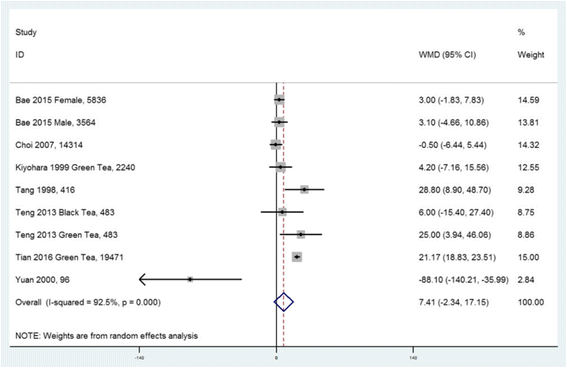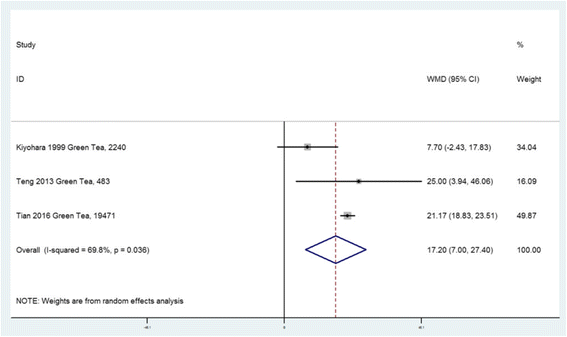Is tea consumption associated with the serum uric acid level, hyperuricemia or the risk of gout? A systematic review and meta-analysis
- PMID: 28245834
- PMCID: PMC5331744
- DOI: 10.1186/s12891-017-1456-x
Is tea consumption associated with the serum uric acid level, hyperuricemia or the risk of gout? A systematic review and meta-analysis
Abstract
Background: The aim of this study was to examine the associations of tea consumption with the serum uric acid (SUA) level, hyperuricemia (HU) and the risk of gout.
Methods: A comprehensive literature search up to June 2016, using PUBMED and EMBASE databases, was conducted to identify the relevant observational studies that examined the associations of tea consumption with the SUA level, HU and the risk of gout.
Results: A total of fifteen observational studies were included in this study, and nine studies were extracted for meta-analysis. For the SUA level, seven studies were included. According to the combined weighted mean difference (WMD), there was no significant difference between the highest and the lowest tea intake category in terms of the SUA level (WMD = 7.41 μmol/L, 95%CI: -2.34 to 17.15; P = 0.136). In subgroup analysis including three studies, green tea consumption was positively associated with the SUA level (WMD = 17.20 μmol/L, 95%CI: 7.00 to 27.40; P = 0.01). For the prevalence of HU, five studies were included. The overall multi-variable adjusted odds ratio (OR) for the highest versus the lowest category of tea consumption was 0.98 (95%CI: 0.77 to 1.24; P = 0.839). For the risk of gout, two prospective cohort studies showed that there was no relationship between tea consumption and the risk of gout in males and females, respectively.
Conclusion: The current evidences suggest that tea consumption does not seem to be associated with the SUA level, HU and the risk of gout. However, due to the limited number of studies, green tea consumption might be positively associated with the SUA level. More well-designed prospective cohort studies are needed to elaborate these issues further.
Keywords: Gout; Hyperuricemia; Meta-analysis; Serum uric acid; Systematic review; Tea.
Figures




Similar articles
-
Is coffee consumption associated with a lower risk of hyperuricaemia or gout? A systematic review and meta-analysis.BMJ Open. 2016 Jul 8;6(7):e009809. doi: 10.1136/bmjopen-2015-009809. BMJ Open. 2016. PMID: 27401353 Free PMC article.
-
Tea consumption, serum uric acid levels and hyperuricemia: a systematic review and meta-analysis.Clin Rheumatol. 2025 Jan;44(1):67-80. doi: 10.1007/s10067-024-07252-4. Epub 2024 Nov 29. Clin Rheumatol. 2025. PMID: 39612018
-
Systemic pharmacological treatments for chronic plaque psoriasis: a network meta-analysis.Cochrane Database Syst Rev. 2021 Apr 19;4(4):CD011535. doi: 10.1002/14651858.CD011535.pub4. Cochrane Database Syst Rev. 2021. Update in: Cochrane Database Syst Rev. 2022 May 23;5:CD011535. doi: 10.1002/14651858.CD011535.pub5. PMID: 33871055 Free PMC article. Updated.
-
Interventions for tophi in gout.Cochrane Database Syst Rev. 2021 Aug 11;8(8):CD010069. doi: 10.1002/14651858.CD010069.pub3. Cochrane Database Syst Rev. 2021. PMID: 34379791 Free PMC article.
-
Drugs for preventing postoperative nausea and vomiting in adults after general anaesthesia: a network meta-analysis.Cochrane Database Syst Rev. 2020 Oct 19;10(10):CD012859. doi: 10.1002/14651858.CD012859.pub2. Cochrane Database Syst Rev. 2020. PMID: 33075160 Free PMC article.
Cited by
-
Dietary Antioxidant Supplements and Uric Acid in Chronic Kidney Disease: A Review.Nutrients. 2019 Aug 15;11(8):1911. doi: 10.3390/nu11081911. Nutrients. 2019. PMID: 31443225 Free PMC article. Review.
-
Potential role of tea drinking in preventing hyperuricaemia in rats: biochemical and molecular evidence.Chin Med. 2022 Sep 15;17(1):108. doi: 10.1186/s13020-022-00664-x. Chin Med. 2022. PMID: 36109783 Free PMC article.
-
Effect of tea intake on genetic predisposition to gout and uric acid: a Mendelian randomization study.Front Endocrinol (Lausanne). 2024 Feb 2;14:1290731. doi: 10.3389/fendo.2023.1290731. eCollection 2023. Front Endocrinol (Lausanne). 2024. PMID: 38440060 Free PMC article.
-
Phytochemical compounds for treating hyperuricemia associated with gout: a systematic review.Naunyn Schmiedebergs Arch Pharmacol. 2025 May;398(5):4779-4801. doi: 10.1007/s00210-024-03686-4. Epub 2024 Dec 5. Naunyn Schmiedebergs Arch Pharmacol. 2025. PMID: 39636406
-
A Bidirectional Mendelian Randomization Study of Tea-Drinking Habits and Risk of Elevated Serum Uric Acid Levels.Int J Rheum Dis. 2025 Feb;28(2):e70128. doi: 10.1111/1756-185X.70128. Int J Rheum Dis. 2025. PMID: 39953773 Free PMC article.
References
-
- Wallace KL, et al. Increasing prevalence of gout and hyperuricemia over 10 years among older adults in a managed care population. J Rheumatol. 2004;31(8):1582–7. - PubMed
Publication types
MeSH terms
Substances
LinkOut - more resources
Full Text Sources
Other Literature Sources
Medical

